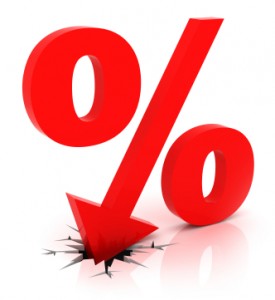In last week’s blog post, we discussed low interest rates and household debt. While the low interest rate environment is encouraging Canadians to borrow money like never before, what about savings? The statistics speak for themselves: savings rates in this country are near a five-year low. Let’s take a closer look at the relationship between low interest rates and savings and why it still makes sense to save.
Low Interest Rates and Savings
While low interest rates are encouraging us to borrow, the same can’t be said about the sad state of savings in this country. The household savings rate is near a five-year low. The household savings rate was a lowly 3.6 percent in the fourth quarter of 2014, the third consecutive decline, according to Statistics Canada.
Why aren’t Canadians saving as much these days? The paltry investment returns might have something to do with it. If you’re parking your money in low risk investments like savings account, GICs and bonds, you should be well aware of the measly investment returns. If you throw inflation into the mix, in most cases your money is shrinking as a saver. For example, if the inflation rate is 1.5 percent and you’re only achieving a 1.3 percent return, you’re losing 0.2 percent after inflation. This is not a great position to be in, to say the least. We haven’t even mentioned taxes yet. If your money is held in a non-registered account, your return is even worse after taxes are taken into consideration.
We seem to be caught in the perfect storm of weak economic growth and low inflation, which has kept interest rates artificially low for the last several years. Low interest rates are supposed to encourage us to borrow money, but with the household debt-to-income ratio near a record of 163.3 percent, the Bank of Canada is worried the latest interest rate cut will encourage us to take on even more debt, as we shun savings for borrowing.
It’s important to note that savings returns weren’t always this pathetic. Person finance columnist Rob Carrick points out in the article, Yes, you’re being penalized for saving (but keep at it, anyway), that savers have been able to earn a positive after-inflation return in past years. If we look at savings rates from Tangerine and we compare it to the long term inflation numbers from Statistics Canada, savers achieved an after-inflation return of 0.8 per cent between 1998 and 2014.
Why You Should Still Save
With all the doom and gloom, what’s a saver to do? Despite low savings returns, savers shouldn’t continue to pile on debt at a record pace. When interest rates do eventually rise, those up their ears in debt will be in for a rude awakening.
Instead of financing everything through debt, consider saving ahead of time. By figuring out how much money you need, you can “pay yourself” by putting money aside from every paycheque. For example, if you’d like to go on a trip to Barcelona, Spain next summer and it costs $2,000, you’ll need to sock away $167 per month over the next 12 months towards your trip. There’s also the rule of Dollar Cost Averaging which encourages you to consistently save regardless of what the interest rates or share prices are, over time you will still come out ahead of someone who only saves when times are good. Furthermore the good savings habits you cultivate are what will eventually allow you to live a more stress free life and really “take care of the things that matter”. It’s forward thinking like that that can keep you out of debt and keep your family’s finances on track.
If you’re looking for savings option that provide a decent return and want to see if your long-term financial goals are on track, feel free to contact our office and let us help you fully weigh your options.









